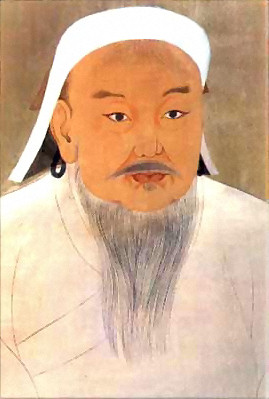(7 December 2006 – 8 April 2007)
One of the books that I have always carried with me on my job assignments (including Japan, Mexico, Korea, many States in America) was ‘’50 Great Turks’’ published by Yedigun Nesriyati in the 50s. The large book, prepared by Ibrahim Alaeddin Govsa and painter Munif Fehim, opens with Attila and ends with ‘’Mehmetcik’’. Major Sultans, Literary Figures, Musicians, Soldiers and Ataturk are included with a picture of each. The 6th great Turk is ‘’Cengiz Han’’, although most will admit that he was Mongolian and not a Turk. Therefore, when advertisements appeared all over Istanbul and many newspapers on the exhibition, I visited the Sabanci Museum in Emirgan on Wednesday, Dec 27, located in a magnificent building in the middle of a beautiful garden that was once the private home of the late Sakip Sabanci.
The visitors are greeted with the sound of running horses and directed to the exhibition that covers three floors. A large panel on the wall states that the exhibition (sponsored by Garanti Bank in cooperation with Bonn, Munich and Vienna Museums) is being staged as a commemoration of the 800th anniversary of the founding of Cengiz Han’s Empire, the largest and the grandest that the world has ever seen, stretching from the Pacific Ocean to the centre of Europe. There are many large paintings, replicas of monuments, archaeological finds, gold and silver pieces, books, Chinese manuscripts, dresses from the various stages of the empire between the 13th and 14th century. It is a well-organized exhibition.
There is a chronology on the life of Cengiz Han, who is identified on his seal as ‘’God in Heaven, The Kha Han, the Power of God on Earth, Emperor of Mankind.’’ His life is told in a series of illuminated panels. Cengiz Han, whose real name was Timucin, was born in a small town in Mongolia in 1155. His father died when he was 12 and in 1202 was picked as the great Khan of all the Mongolian and Tatar tribes and became the Emperor in 2006 as Cengiz Han, a name given to him by a soothsayer named Saman. Before he died in 1227 at the age of 72, Cengiz Han made sure that his vast empire would be governed by his sons in an orderly manner and one of his grandsons, Batur Han, established the State of Altinordu in the north of the Black Sea now known as Crimea.
Unfortunately, there were no brochures or a catalogue of the Exhibition, which is unusual for private museums. I was told that it was under preparation. In his column in Cumhuriyet’s Weekly Magazine, A. M. Celal Sengor gives information on the background of the exhibition and states that Prof. Halil Berktay of Sabanci University was one of the members of the ‘’Scientific Advisory Board’’ for the museum and wonders why. Evidently almost all of the artefacts at the exhibition were exhibited in Bonn and in Munich in September and October 2005, with a few additions from the Museums in Turkey. I was bothered after reading Mr. Sengor’s article that this information was not made public, feeling deceived not having been told about the background of the exhibition and what Prof. Berktay’s involvement could be.
Yuksel Oktay
December 30, 2006
Istanbul

